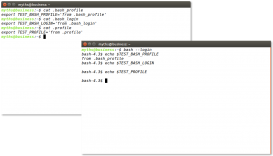前言
本文主要给大家介绍了关于linux常用命令last用法的相关内容,分享出来供大家参考学习,话不多说,来一起看看详细的介绍吧。
命令简介:
该命令用来列出目前与过去登录系统的用户相关信息。指令英文原义:show listing of last logged in users
执行权限 :有些需要特殊权限
指令所在路径:/usr/bin/last
执行last指令时,它会读取位于/var/log目录下名称为wtmp的文件,并把该给文件的内容记录的登录系统的用户名单全部显示出来。默认是显示wtmp的记录,btmp能显示的更详细,可以显示远程登录,例如ssh登录。
utmp文件中保存的是当前正在本系统中的用户的信息。
wtmp文件中保存的是登录过本系统的用户的信息。
命令输出字段介绍:
第一列:用户名
第二列:终端位置。pts/0 (伪终端) 意味着从诸如ssh或telnet的远程连接的用户.tty (teletypewriter) 意味着直接连接到计算机或者本地连接的用户
第三列:登录ip或者内核 。如果你看见:0.0 或者什么都没有,这意味着用户通过本地终端连接。除了重启活动,内核版本会显示在状态中。
第四列:开始时间
第五列:结束时间(still login in 还未退出 down 直到正常关机 crash 直到强制关机)
第六列:持续时间
命令语法:
last [-r] [-num] [ -n num ] [-adiowx] [ -f file ] [ -t yyyymmddhhmmss ] [name...] [tty...]
命令参数:
|
参数 |
长参数 |
描叙 |
|
-a |
将登录系统的的主机名称或ip地址,显示在最后一行 |
|
|
-d |
将ip地址转换成主机名称 |
|
|
-f |
指定记录文件,默认是显示/var/log目录下的wtmp文件的记录,但/var/log目录下得btmp能显示的内容更丰富,可以显示远程登录,例如ssh登录 ,包括失败的登录请求。 |
|
|
-i |
-i显示特定ip登录的情况。跟踪用 -i显示特定ip登录的情况。跟踪用 |
|
|
-o |
read an old-type wtmp file (written by linux-libc5 applications). |
|
|
-n |
-n <显示行数>或-<显示行数> 设置显示多少行记录 |
|
|
-w |
display full user and domain names in the output |
|
|
-r |
不显示登入系统的主机名称或ip(省略 hostname 的栏位) |
|
|
-t |
显示yyyymmddhhmmss之前的信息 |
|
|
-x |
显示系统关闭、用户登录和退出的历史 |
使用示例:
1:查看last命令的帮助信息
|
1
2
3
4
5
6
7
|
[root@db-server ~]# man last [root@db-server ~]# last -hlast: invalid option -- husage: last [-num | -n num] [-f file] [-t yyyymmddhhmmss] [-r] [-x] [-o] [-w] [username..] [tty..] |
2:显示最后登录系统的n条记录
|
1
2
3
4
5
6
7
8
9
10
11
12
13
14
15
16
17
18
19
20
21
22
23
24
25
26
27
|
[root@db-server ~]#last -10root pts/1 :0.0 wed dec 18 09:54 still logged inroot pts/4 :0.0 wed dec 18 09:43 - 09:48 (00:04) root pts/1 :0.0 wed dec 18 09:43 - 09:48 (00:05) root pts/3 192.168.103.79 wed dec 18 09:41 - 12:40 (02:59) root pts/4 :0.0 wed dec 18 09:28 - 09:30 (00:01) root pts/3 :0.0 wed dec 18 09:27 - 09:30 (00:02) root pts/2 192.168.103.29 wed dec 18 09:27 still logged inroot pts/1 :0.0 wed dec 18 09:27 - 09:42 (00:15) root pts/2 :0.0 wed dec 18 09:23 - 09:25 (00:01) root pts/1 :0.0 wed dec 18 09:22 - 09:25 (00:02) wtmp begins wed dec 11 03:02:17 2013 [root@db-server ~]# last -n 10root pts/1 :0.0 wed dec 18 09:54 still logged inroot pts/4 :0.0 wed dec 18 09:43 - 09:48 (00:04) root pts/1 :0.0 wed dec 18 09:43 - 09:48 (00:05) root pts/3 192.168.103.79 wed dec 18 09:41 - 12:40 (02:59) root pts/4 :0.0 wed dec 18 09:28 - 09:30 (00:01) root pts/3 :0.0 wed dec 18 09:27 - 09:30 (00:02) root pts/2 192.168.103.29 wed dec 18 09:27 still logged inroot pts/1 :0.0 wed dec 18 09:27 - 09:42 (00:15) root pts/2 :0.0 wed dec 18 09:23 - 09:25 (00:01) root pts/1 :0.0 wed dec 18 09:22 - 09:25 (00:02) wtmp begins wed dec 11 03:02:17 2013 |
3:将登录系统的主机名或ip地址显示在最后一行
|
1
2
3
4
5
6
7
8
9
10
11
12
13
|
[root@db-server ~]# last -10 -aroot pts/1 wed dec 18 09:54 still logged in :0.0root pts/4 wed dec 18 09:43 - 09:48 (00:04) :0.0root pts/1 wed dec 18 09:43 - 09:48 (00:05) :0.0root pts/3 wed dec 18 09:41 - 12:40 (02:59) 192.168.103.79root pts/4 wed dec 18 09:28 - 09:30 (00:01) :0.0root pts/3 wed dec 18 09:27 - 09:30 (00:02) :0.0root pts/2 wed dec 18 09:27 still logged in 192.168.103.29root pts/1 wed dec 18 09:27 - 09:42 (00:15) :0.0root pts/2 wed dec 18 09:23 - 09:25 (00:01) :0.0root pts/1 wed dec 18 09:22 - 09:25 (00:02) :0.0 wtmp begins wed dec 11 03:02:17 2013 |
4:不显示登入系统的主机名称或ip地址
|
1
2
3
4
5
6
7
8
9
10
11
12
13
|
[root@db-server ~]# last -10 -rroot pts/1 wed dec 18 09:54 still logged inroot pts/4 wed dec 18 09:43 - 09:48 (00:04) root pts/1 wed dec 18 09:43 - 09:48 (00:05) root pts/3 wed dec 18 09:41 - 12:40 (02:59) root pts/4 wed dec 18 09:28 - 09:30 (00:01) root pts/3 wed dec 18 09:27 - 09:30 (00:02) root pts/2 wed dec 18 09:27 still logged inroot pts/1 wed dec 18 09:27 - 09:42 (00:15) root pts/2 wed dec 18 09:23 - 09:25 (00:01) root pts/1 wed dec 18 09:22 - 09:25 (00:02) wtmp begins wed dec 11 03:02:17 2013 |
5: 指定/var/log/btmp文件,查看登录系统的用户相关信息
|
1
2
3
4
5
6
7
8
9
10
11
12
13
|
[root@db-server ~]# last -n 10 -f /var/log/btmproot ssh:notty 192.168.136.163 fri oct 17 18:16 gone - no logoutroot ssh:notty 192.168.136.163 fri oct 17 09:50 - 18:16 (08:26) root ssh:notty 192.168.136.163 fri oct 17 09:50 - 09:50 (00:00) root ssh:notty 192.168.40.218 tue jul 23 17:40 - 09:50 (450+16:10) root ssh:notty 192.168.236.149 sun apr 14 01:34 - 17:40 (100+16:05) root ssh:notty 192.168.178.147 fri mar 8 17:25 - 01:34 (36+08:08) tomcat ssh:notty get185806.gfg1.e fri oct 26 16:48 - 17:25 (133+00:37) root ssh:notty 192.168.193.3 mon oct 22 18:13 - 16:48 (3+22:34) root ssh:notty 192.168.193.3 mon oct 22 18:13 - 18:13 (00:00) devloper ssh:notty get185819.gfg1.e wed oct 17 17:22 - 18:13 (5+00:50) btmp begins thu apr 12 14:30:06 2012 |
6: 将ip地址转换成主机名称
|
1
|
last -10 -d |

7: 显示yyyymmddhhmmss(20150110093000)之前的信息
|
1
2
3
4
5
6
7
8
9
10
11
12
13
|
[root@db-server ~]# last -10 -t 20150110093000root pts/2 192.168.102.186 fri jan 9 15:35 - 17:27 (01:52) root pts/2 192.168.102.134 thu jan 8 10:25 - 12:27 (02:02) root pts/3 192.168.125.53 tue jan 6 23:59 - 00:09 (00:09) root pts/2 192.168.125.53 tue jan 6 23:45 - 00:09 (00:23) root pts/3 192.168.102.88 tue jan 6 15:23 - 16:20 (00:57) root pts/2 192.168.102.88 tue jan 6 15:08 - 17:25 (02:16) oracle pts/1 :2.0 tue jan 6 15:07 still logged inreboot system boot 2.6.32-200.13.1. tue jan 6 15:07 (7+20:21) root pts/2 192.168.102.88 tue jan 6 14:47 - down (00:17) oracle pts/1 :2.0 tue jan 6 14:46 - down (00:18) wtmp begins wed apr 11 16:31:10 2012 |
总结
以上就是这篇文章的全部内容了,希望本文的内容对大家的学习或者工作能带来一定的帮助,如果有疑问大家可以留言交流,谢谢大家对服务器之家的支持。
原文链接:http://www.cnblogs.com/kerrycode/p/4223751.html















